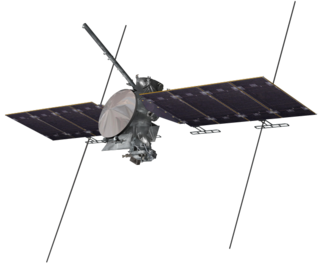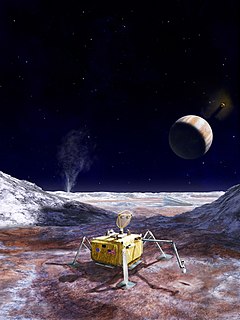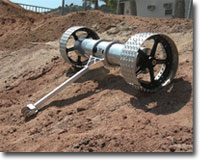Related Research Articles

The Jet Propulsion Laboratory (JPL) is a federally funded research and development center and NASA field center in the city of La Cañada Flintridge with a Pasadena mailing address, within the state of California, United States.

2001 Mars Odyssey is a robotic spacecraft orbiting the planet Mars. The project was developed by NASA, and contracted out to Lockheed Martin, with an expected cost for the entire mission of US$297 million. Its mission is to use spectrometers and a thermal imager to detect evidence of past or present water and ice, as well as study the planet's geology and radiation environment. It is hoped that the data Odyssey obtains will help answer the question of whether life existed on Mars and create a risk-assessment of the radiation that future astronauts on Mars might experience. It also acts as a relay for communications between the Curiosity rover, and previously the Mars Exploration Rovers and Phoenix lander, to Earth. The mission was named as a tribute to Arthur C. Clarke, evoking the name of 2001: A Space Odyssey.

Mars Global Surveyor (MGS) was an American robotic spacecraft developed by NASA's Jet Propulsion Laboratory and launched November 1996. Mars Global Surveyor was a global mapping mission that examined the entire planet, from the ionosphere down through the atmosphere to the surface. As part of the larger Mars Exploration Program, Mars Global Surveyor performed monitoring relay for sister orbiters during aerobraking, and it helped Mars rovers and lander missions by identifying potential landing sites and relaying surface telemetry.

The planet Mars has been explored remotely by spacecraft. Probes sent from Earth, beginning in the late 20th century, have yielded a large increase in knowledge about the Martian system, focused primarily on understanding its geology and habitability potential. Engineering interplanetary journeys is complicated and the exploration of Mars has experienced a high failure rate, especially the early attempts. Roughly sixty percent of all spacecraft destined for Mars failed before completing their missions and some failed before their observations could begin. Some missions have met with unexpected success, such as the twin Mars Exploration Rovers, which operated for years beyond their specification.

The Discovery Program is a series of Solar System exploration missions funded by the US National Aeronautics and Space Administration (NASA) through its Planetary Missions Program Office. Each mission has a cost cap, at a lower level than a mission from NASA's New Frontiers or Flagship Programs. As a result, Discovery missions tend to be more focused on a specific scientific goal.

A Mars Sample-Return (MSR) mission would be a spaceflight mission to collect rock and dust samples on Mars and then return them to Earth. Sample-return would be a very powerful type of exploration, because the analysis is freed from the time, budget, and space constraints of spacecraft sensors.

A space probe is a robotic spacecraft that does not orbit Earth, but instead, explores further into outer space. A space probe may approach the Moon; travel through interplanetary space; flyby, orbit, or land on other planetary bodies; or enter interstellar space.

Endeavour is an impact crater located in the Meridiani Planum extraterrestrial plain within the Margaritifer Sinus quadrangle (MC-19) region of the planet Mars. Endeavour is about 22 kilometers (14 mi) in diameter. Using Mars Reconnaissance Orbiter data, phyllosilicate-bearing outcrops have been detected along its rim. These minerals may have formed under wet conditions in a low-acidic environment during the early history of Mars. There are raised rim segments to the north, east, and southwest. The rim has become worn, rounded and degraded, with infilling of plains material in a manner similar to the Victoria crater.
Peter H. Schultz is Professor of Geological Sciences at Brown University specializing in the study of planetary geology, impact cratering on the Earth and other objects in the Solar System, and volcanic modifications of planetary surfaces. He was co-investigator to the NASA Science Mission Directorate spacecraft Deep Impact and the Lunar Crater Observation and Sensing Satellite (LCROSS). He was awarded the Barringer Medal of the Meteoritical Society in 2004 for his theoretical and experimental studies of impact craters.

Lunar lava tubes are tunnels on the Moon that are thought to have formed during basaltic lava flows. When the surface of a lava tube cools, it forms a hardened lid that channels the lava as it continues to flow beneath the surface in a conduit-shaped passage. Once the flow of lava diminishes, the tunnel may drain, forming a hollow void. Lunar lava tubes are formed on sloped surfaces that range in angle from 0.4° to 6.5°. These tubes may be as wide as 500 metres (1,600 ft) before they become unstable against gravitational collapse. However, stable tubes may still be disrupted by seismic events or meteoroid bombardment.

Mars Exploration Program (MEP) is a long-term effort to explore the planet Mars, funded and led by NASA. Formed in 1993, MEP has made use of orbital spacecraft, landers, and Mars rovers to explore the possibilities of life on Mars, as well as the planet's climate and natural resources. The program is managed by NASA's Science Mission Directorate by Doug McCuistion of the Planetary Science Division. As a result of 40% cuts to NASA's budget for fiscal year 2013, the Mars Program Planning Group (MPPG) was formed to help reformulate the MEP, bringing together leaders of NASA's technology, science, human operations, and science missions.

Europa Clipper is an interplanetary mission in development by NASA comprising an orbiter. Set for a launch in 2024, the spacecraft is being developed to study the Galilean moon Europa through a series of flybys while in orbit around Jupiter.

Amanda R. Hendrix, Ph.D. is an American planetary scientist known for her pioneering studies of solar system bodies at ultraviolet wavelengths. She is a senior scientist at the Planetary Science Institute. Her research interests include moon and asteroid surface composition, space weathering effects and radiation products. She is a co-investigator on the Cassini UVIS instrument, was a co-investigator on the Galileo UVS instrument, is a Participating Scientist on the Lunar Reconnaissance Orbiter LAMP instrument and is a Principal Investigator on Hubble Space Telescope observing programs. As of 2019, she is also the co-lead of the NASA Roadmaps to Oceans World Group.

The Europa Lander is a proposed astrobiology mission concept by NASA to Europa, an icy moon of Jupiter. If funded and developed as a Flagship mission, it would be launched in 2025 to complement the studies by the Europa Clipper orbiter mission and perform analyses on site.

Sarah Milkovich is lead of Science Operations for the Mars 2020 rover at Jet Propulsion Laboratory. She was investigation scientist for the HiRISE camera on the Mars Reconnaissance Orbiter.
Candice Joy Hansen-Koharcheck is a planetary scientist. She is responsible for the development and operation of the JunoCam, for which she received the NASA's Outstanding Public Leadership Medal in 2018.

Moon Diver is a proposed lunar mission concept by NASA's Jet Propulsion Laboratory that would employ a robotic lander and a two-wheeled rover called Axel to investigate the exposed geological layers on the walls of a deep lunar pit.
References
- ↑ Kerber, Laura. "Science - Planetary Chemistry and Astrobiology (3225): People: Laura Kerber". science.jpl.nasa.gov. Retrieved 2018-04-08.
- ↑ "Admitted Students: Welcome New Sagehens!". Pomona College. 3 June 2016. Retrieved 16 August 2020.
- ↑ "Lecture: Moon Diver Mission Concept - Descending into a Moon Cave to Better Understand the Solar System's Largest Volcanic Eruptions". kiss.caltech.edu. Retrieved 2018-04-08.
- ↑ KISSCaltech (2018-04-03), Moon Diver Mission Concept , retrieved 2018-04-08
- ↑ NASA, JPL. "Mission Team - Mars Odyssey". mars.nasa.gov. Retrieved 2018-04-08.
- ↑ "NASA Moves Longest-Serving Mars Spacecraft for New Observations". NASA/JPL. Retrieved 2018-04-08.
| This United States astronomer article is a stub. You can help Wikipedia by expanding it. |